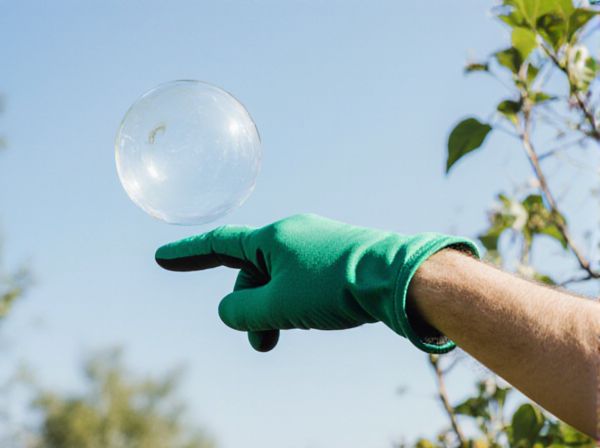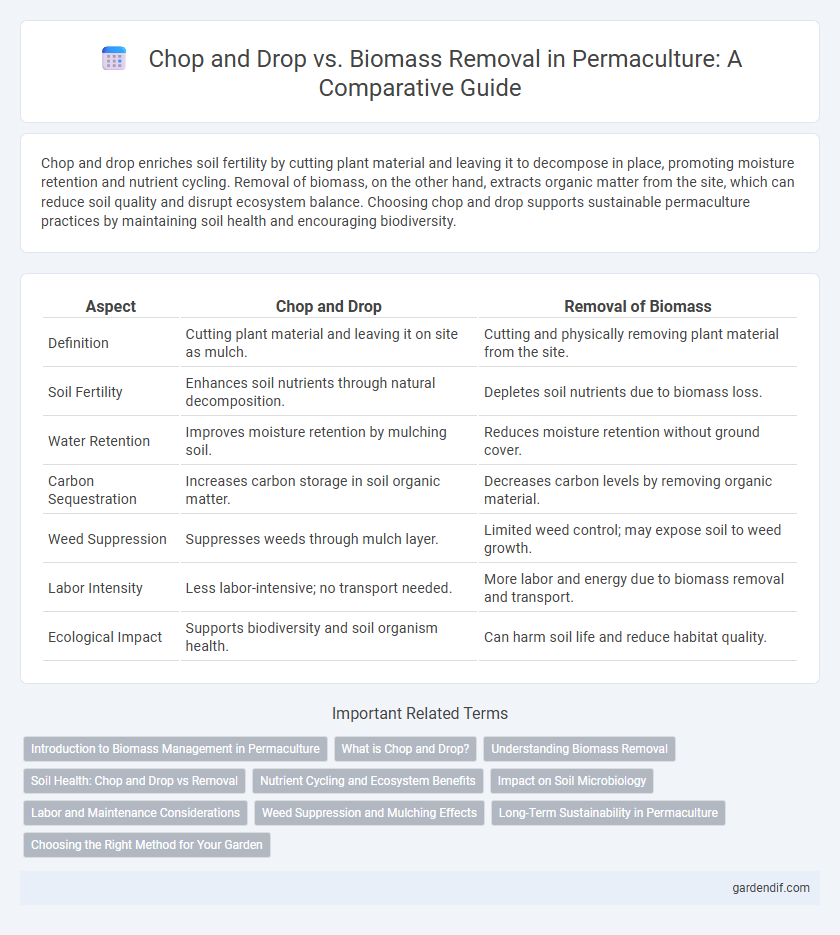
Chop and Drop vs Removal of Biomass Illustration
Chop and drop enriches soil fertility by cutting plant material and leaving it to decompose in place, promoting moisture retention and nutrient cycling. Removal of biomass, on the other hand, extracts organic matter from the site, which can reduce soil quality and disrupt ecosystem balance. Choosing chop and drop supports sustainable permaculture practices by maintaining soil health and encouraging biodiversity.
Table of Comparison
| Aspect | Chop and Drop | Removal of Biomass |
|---|---|---|
| Definition | Cutting plant material and leaving it on site as mulch. | Cutting and physically removing plant material from the site. |
| Soil Fertility | Enhances soil nutrients through natural decomposition. | Depletes soil nutrients due to biomass loss. |
| Water Retention | Improves moisture retention by mulching soil. | Reduces moisture retention without ground cover. |
| Carbon Sequestration | Increases carbon storage in soil organic matter. | Decreases carbon levels by removing organic material. |
| Weed Suppression | Suppresses weeds through mulch layer. | Limited weed control; may expose soil to weed growth. |
| Labor Intensity | Less labor-intensive; no transport needed. | More labor and energy due to biomass removal and transport. |
| Ecological Impact | Supports biodiversity and soil organism health. | Can harm soil life and reduce habitat quality. |
Introduction to Biomass Management in Permaculture
Chop and Drop is a sustainable biomass management technique in permaculture that involves cutting plants and leaving the organic material on-site to decompose, enriching soil fertility and promoting moisture retention. In contrast, removal of biomass extracts organic matter from the system, potentially depleting soil nutrients and reducing ecosystem resilience. Effective biomass management prioritizes nutrient cycling, soil structure improvement, and biodiversity enhancement to create a self-sustaining permaculture system.
What is Chop and Drop?
Chop and Drop is a permaculture technique where plants are cut and left on the soil surface to decompose, enriching the soil with organic matter and nutrients. Unlike removal of biomass, this method recycles plant material in situ, improving soil structure, moisture retention, and microbial activity. This process mimics natural leaf litter cycles, promoting sustainable nutrient cycling and reducing the need for external fertilizers.
Understanding Biomass Removal
Understanding biomass removal in permaculture involves evaluating the impact of extracting organic material from the system versus using chop and drop techniques. Removing biomass can deplete soil nutrients and reduce organic matter, leading to diminished soil fertility and microbial activity. In contrast, chop and drop returns nutrients directly to the soil surface, enhancing soil structure, moisture retention, and promoting a sustainable nutrient cycle.
Soil Health: Chop and Drop vs Removal
Chop and drop enhances soil health by returning organic matter and nutrients directly to the soil surface, promoting microbial activity and moisture retention. Removal of biomass depletes essential nutrients and reduces organic carbon, leading to decreased soil fertility and structure. Maintaining biomass on-site through chop and drop supports long-term soil resilience and ecosystem balance in permaculture systems.
Nutrient Cycling and Ecosystem Benefits
Chop and drop enhances nutrient cycling by allowing plant residues to decompose in place, enriching the soil with organic matter and supporting soil microorganisms. Removal of biomass disrupts this process, depleting soil nutrients and reducing microbial activity essential for ecosystem health. Maintaining on-site biomass through chop and drop promotes soil fertility, moisture retention, and resilience in permaculture systems.
Impact on Soil Microbiology
Chop and drop enhances soil microbiology by leaving organic matter on the ground, fostering microbial diversity and nutrient cycling through decomposition and root interaction. Removal of biomass disrupts this process, reducing organic inputs and diminishing microbial habitats, which can impair soil health and fertility over time. Maintaining on-site biomass supports a rich soil microbiome essential for sustainable permaculture systems.
Labor and Maintenance Considerations
Chop and drop techniques significantly reduce labor and maintenance by recycling organic matter directly on-site, eliminating the need for biomass transport and disposal. Removal of biomass demands additional effort and time for collection, hauling, and off-site management, increasing overall labor intensity. Incorporating chop and drop in permaculture systems enhances soil health while streamlining maintenance routines and minimizing resource input.
Weed Suppression and Mulching Effects
Chop and Drop enhances weed suppression by allowing chopped biomass to form a natural mulch layer that conserves soil moisture, reduces weed seed germination, and improves soil fertility through gradual decomposition. In contrast, removal of biomass eliminates organic material that could serve as mulch, often requiring additional inputs to control weeds and maintain soil health. Effective mulching through Chop and Drop supports a sustainable permaculture system by fostering microbial activity and providing continuous nutrient cycling.
Long-Term Sustainability in Permaculture
Chop and drop enhances long-term sustainability in permaculture by recycling nutrients directly back into the soil, improving soil structure and moisture retention while reducing erosion. Removal of biomass, though sometimes necessary, can deplete essential organic matter and disrupt microbial ecosystems, undermining soil fertility over time. Prioritizing chop and drop practices supports continuous nutrient cycling, promotes biodiversity, and stabilizes agroecosystem productivity.
Choosing the Right Method for Your Garden
Chop and drop enhances soil fertility by leaving organic matter to decompose naturally, enriching microbial activity and moisture retention in permaculture gardens. Biomass removal, while reducing potential pests and diseases, requires supplemental soil amendments to maintain nutrient levels and can disrupt soil structure. Selecting the appropriate method depends on garden goals, soil health status, and ecosystem balance, optimizing plant growth and long-term sustainability.
Chop and Drop vs Removal of Biomass Infographic

 gardendif.com
gardendif.com